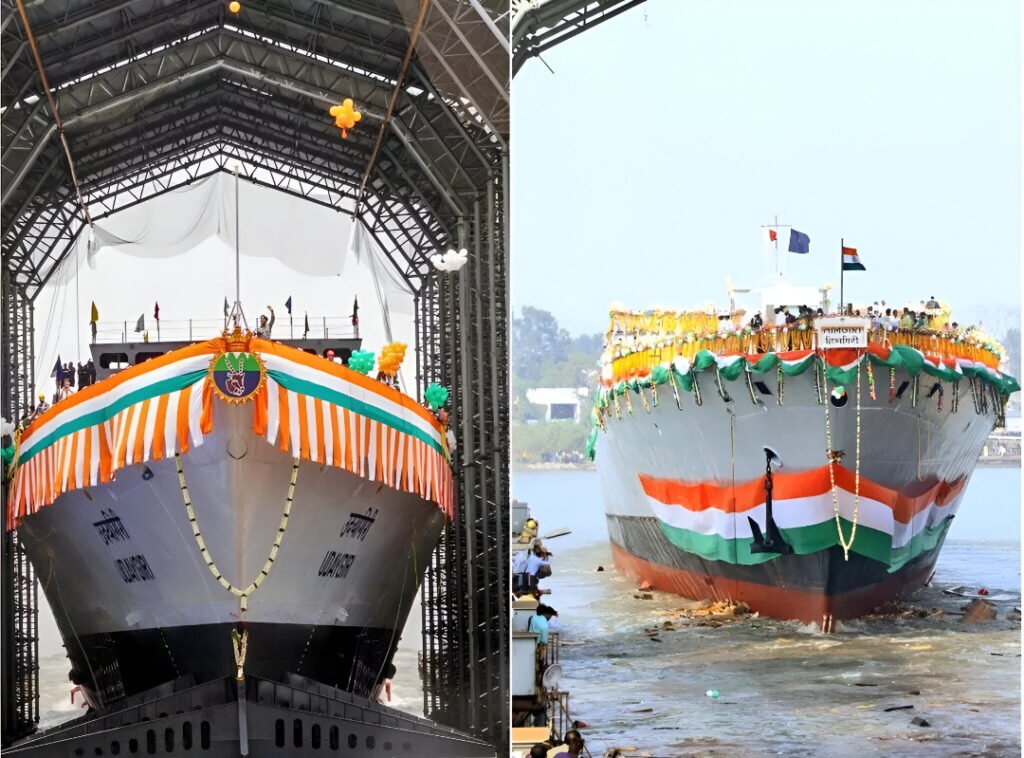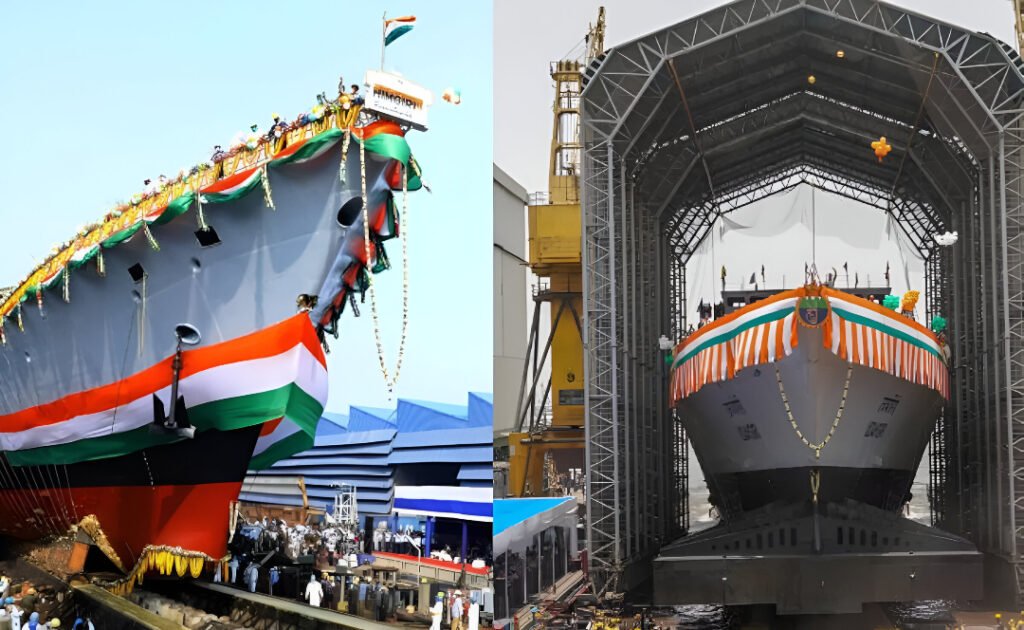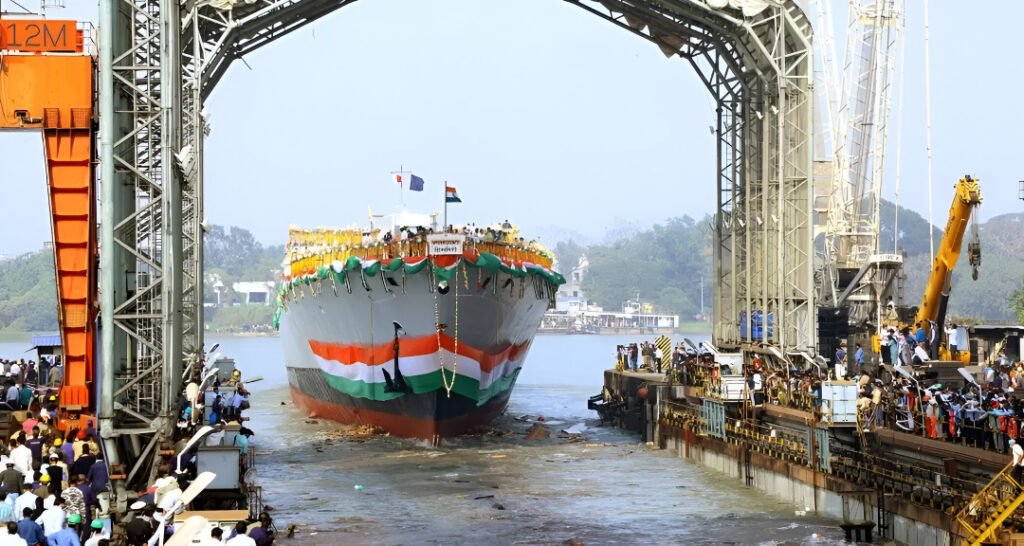On 26 August 2025, Defence Minister Rajnath Singh commissioned two Project 17A stealth frigates—INS Udaygiri and INS Himgiri—at the Eastern Naval Command in Visakhapatnam and declared that “no future ship will be built abroad” as India pushes indigenous warship production.

The twin induction strengthens the Eastern Fleet’s firepower and is a high-profile validation of India’s shipbuilding drive: both vessels are part of the Nilgiri (P17A) program designed in India with roughly 75% indigenous content, marking a political and industrial step toward defense self-reliance and export-ready capacity.
Twin commissioning: a maritime milestone
The simultaneous commissioning is historic: Udaygiri (built by Mazagon Dock Shipbuilders Limited, Mumbai) and Himgiri (built by Garden Reach Shipbuilders & Engineers, Kolkata) are among a seven-ship class designed by the Navy’s Warship Design Bureau. This is the first occasion where two frontline surface combatants, constructed at two different Indian shipyards, have been inducted at the same time—an outcome the Defence Ministry and Navy present as proof of coordinated industrial depth.
What the ships bring to India’s navy
Project 17A frigates are multi-mission stealth platforms built for anti-surface, anti-air, and anti-submarine warfare. Reported specifications include a displacement in the ~6,700-tonne class, advanced signature-reduction features, a combined diesel-and-gas (CODAG) propulsion system, and modern combat suites integrating long-range air defense and surface-strike weapons. The vessels will carry airborne assets (helicopters), torpedoes, and point-defense systems—capabilities that raise eastern seaboard patrol endurance and layered defense of sea lines of communication.

Indigenous push—Rajnath Singh’s pledge and policy context
At the commissioning, Rajnath Singh framed the event as a vindication of the “Aatmanirbhar” shipbuilding strategy and warned that future warships will be constructed domestically. That pledge echoes long-running policy shifts: following earlier imports and transfers, India has steadily increased local design, block-construction techniques, and MSME participation in naval supply chains. Officials note roughly 75% indigenous content for the P17A program and highlight the role of more than 200 MSMEs in building Himgiri.
Strategic impact: Eastern Fleet and Indo-Pacific posture
Commissioning two stealth frigates into the Eastern Fleet strengthens India’s capacity to monitor and respond in the Bay of Bengal and broader Indo-Pacific—a region of rising maritime competition. The ships expand options for task-group deployments, anti-submarine patrols, and humanitarian-assistance missions while signaling India’s intention to sustain blue-water operations with homegrown platforms. Defense analysts say the timing also underscores the government’s push to convert design expertise into production volume and export potential.
What’s next—deployments and the shipbuilding pipeline
- Operational integration: Both frigates will undergo post-commissioning trials and integrate with the Eastern Fleet’s operational schedules; expect deployment on patrols, exercises, and naval diplomacy missions in the coming months.
- Remaining P17A schedule: The Nilgiri class includes seven hulls overall; other ships are at various stages of outfitting, trials, and delivery as shipyards ramp up modular block construction.
- Industry goals: The defense ministry and shipyards aim to improve cycle times, increase indigenous systems (ultimately including sensors and propulsion), and position India to co-develop or export frigates in future defense diplomacy. Rajnath Singh’s “no future ship built abroad” line signals political intent to prioritize these outcomes.

According to the Press Information Bureau and Indian Navy briefings on the Visakhapatnam commissioning, INS Udaygiri and INS Himgiri were formally inducted into the fleet on 26 Aug 2025; the PIB noted the simultaneous commissioning and the ships’ role in augmenting maritime security. Reporting and technical context are drawn from coverage by The Times of India, Economic Times, Indian Express, India Today, and Hindustan Times, which carried Rajnath Singh’s remarks and program details.
Conclusion
The commissioning of INS Udaygiri and INS Himgiri is both symbolic and practical: symbolically, it advances India’s narrative of defense self-reliance; practically, it injects two modern, stealthy frigates into the Eastern Fleet at a time of intensifying regional maritime competition. Rajnath Singh’s pledge that future ships will not be built abroad sets a political baseline—turning that promise into durable capability will depend on faster industrial throughput, deeper indigenization of critical systems, and a steady pipeline of contracts that convert design knowledge into sovereign production and, eventually, exportable warships.











